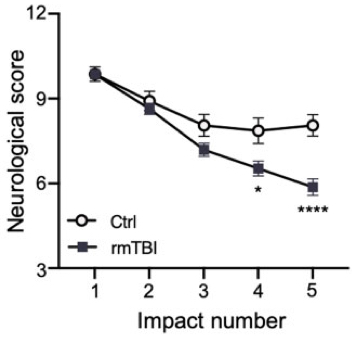Epilepsy
TGF-beta Signaling in Post-Traumatic Epileptogenesis: Novel Mechanisms and Therapeutic Target



Posted November 22, 2022
Alon Friedman, M.D., Ph.D., Dalhousie University, Halifax, N.S., Canada
 Dr. Alon Friedman
Dr. Alon Friedman (Photo provided)
While standard care has significantly improved the probability of surviving a Traumatic Brain Injury (TBI), patients will often later develop secondary debilitating conditions, including Post-Traumatic Epilepsy (PTE). It is still unclear how mechanisms resulting from initial injury develop into PTE, but the Epilepsy Research Program (ERP) is dedicated to meeting this need through supporting research to advance care strategies, improve long-term recovery, and ultimately prevent disease. Currently, many ERP research efforts are focused on examining the brain's immune response to injury, which seems to contribute to aberrant neuron network re-organizations that play a key role in epileptogenesis.
For two decades, Drs. Alon Friedman and Daniela Kaufer have been collaborating on studying disorders affecting the blood vessels supplying the brain, specifically a key hallmark of brain blood vessels, also known as the blood-brain barrier (BBB). The BBB is a complex structural and functional feature of brain blood vessels that separates the brain from the rest of the body and is essential for healthy brain function. Following TBI, the BBB is damaged, and blood components, such as albumin leak into the brain, causing an immune response. Astrocytes, one of the cell types that contribute to the BBB, are key players in the brain's immune and repair response and, upon brain injury, astrocytes are activated.
 Figure 1: Neurological scores significantly decline with repeated mild traumatic brain injury (rmTBI) compared to controls, using a
Figure 1: Neurological scores significantly decline with repeated mild traumatic brain injury (rmTBI) compared to controls, using a Dr. Friedman studies the effects of astrocyte activation following TBI and determined that these cells actually detect leaked albumin in the brain, which bind to their TGF-Beta (TGF-B) receptors, thereby initiating inflammatory signaling, which may be an underlying cause of PTE development. Utilizing two different TBI models with either a mild or moderate non-penetrating injury pattern in a Fiscal Year 2016 Department of Defense ERP Idea Development Award, Drs. Friedman and Kaufer leveraged TGF-B signaling pathway to quantify and describe damage to the BBB resulting from variable TBI injuries and investigate whether blocking TGF-B signaling could prevent PTE.
Drs. Friedman and Kaufer's research efforts, supported by the ERP, combine techniques of behavior testing, continuous brain recording from free-roaming animals, and molecular biology to investigate the development of epilepsy up to nine months following TBI. They found with increasing trauma severity, the extent of BBB damage also increased. The moderate TBI model resulted in an immediate brain "bruise," with epilepsy occurring in 50% of animals by four weeks and 75% by eight weeks post-injury. Comparatively, the mild TBI model produced a more diffuse brain injury that resulted in temporary brain signaling changes without observable anatomical damage, similar to mild TBI (i.e., concussion) in humans. Monitoring brain activity in both animal models immediately following a TBI revealed the injury frequently induces silencing in overall neural network activity that propagates throughout the brain (AKA 'spreading depolarization'), as well as BBB dysfunction and behavioral deficits.
Moreover, in this project, the group developed MRI techniques with enhanced contrast for visualizing the "leakiness" of the injured BBB. Using these new techniques, they can assess progressive changes in animals, including those that experienced consecutive brain injuries, to show how multiple impacts contribute to worsening neurological complications and PTE development (Figure 1).1 After three mild impacts, significant BBB damage was observed, similar to a single moderate impact, showing increased blood proteins in the brain (more BBB leakage), greater TGF-B inflammation, behavioral decline, and brain cell swelling. Given the high prevalence of concussion in the general population, and even more concerning, the prevalence of multiple concussions, understanding the different molecular and physiological consequences of single vs. multiple brain injuries is critical to determining who may be at risk of developing PTE and to the development of targeted therapies to prevent epileptogenesis.
 Figure 2: Following TBI, treatment with Losartan (los) or IPW-5371(IPW) prevents PTE by minimizing seizure occurrence by 6 months.
Figure 2: Following TBI, treatment with Losartan (los) or IPW-5371(IPW) prevents PTE by minimizing seizure occurrence by 6 months. In addition to describing the molecular and physiological consequences of various TBIs, Drs. Friedman and Kaufer also investigated the contribution of TGF-B signaling in post-injury outcomes. Because mechanisms leading to PTE are unknown, currently there are no drugs to treat the specific effects from injury that cause PTE. To this end, the groups have tested two drugs targeting suppression of the TGF-B pathway in both models as a way to treat or prevent PTE: Losartan, which is approved by the U.S. Food and Drug Administration to treat hypotension, and a novel small molecule, IPW-5371, which is being fully developed and characterized with academic collaborators. Findings from these initial studies showed that both drugs minimized BBB damage and occurrence of seizures and PTE, as well as subsequent behavioral deficits (Figure 2). Of the two, Losartan had the most favorable benefits within 48 hours, making it a promising option for PTE prevention. These therapeutic efforts are vital to improving outcomes for PTE patients whose seizures are often not well controlled and resistant to standard anti-epileptic drugs, leaving them with disability and the financial burden of continued care.
Further work is still needed to explore these therapeutic treatments, but having new biomarkers that can be used to monitor PTE development and evidence for the contribution of TGF-B signaling in PTE will go a long way to defining and preventing the mechanisms contributing to PTE.
References:
1Parker E, Aboghazleh R, Mumby G, Veksler R, Ofer J, Newton J, Smith R, Kamintsky L, Jones CMA, O'Keeffe E, Kelly E, Doelle K, Roach I, Yang LT, Moradi P, Lin JM, Gleason AJ, Atkinson C, Bowen C, Brewer KD, Doherty CP, Campbell M, Clarke DB, van Hameren G, Kaufer D, Friedman A. Concussion susceptibility is mediated by spreading depolarization-induced neurovascular dysfunction. Brain. 2022 Jun 30;145(6):2049-2063. doi: 10.1093/brain/awab450. PMID: 34927674; PMCID: PMC9246711.
Last updated Monday, March 10, 2025














